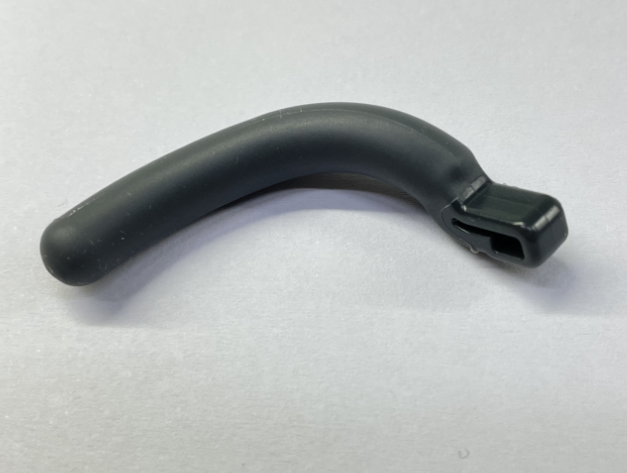A part del modelat per injecció normal, que utilitzem habitualment per a la producció de peces d'un sol material, el sobremodelat i la doble injecció (també conegut com a modelat en dos o modelat per injecció multimaterial) són processos de fabricació avançats que s'utilitzen per crear productes amb múltiples materials o capes. Aquí teniu una comparació detallada dels dos processos, inclosa la seva tecnologia de fabricació, les diferències en l'aspecte del producte final i els escenaris d'ús típics.
Sobremoldeig
Procés de tecnologia de fabricació:
Moldeig inicial de components:
El primer pas consisteix a modelar el component base mitjançant un procés estàndard de modelat per injecció.
Moldeig secundari:
El component base emmotllat es col·loca en un segon motlle on s'injecta el material de sobremotllament. Aquest material secundari s'uneix al component inicial, creant una única peça cohesionada amb múltiples materials.
Selecció de materials:
El sobremoldeig normalment implica l'ús de materials amb propietats diferents, com ara una base de plàstic dur i un sobremoldeig d'elastòmer més tou. L'elecció dels materials depèn de les propietats desitjades del producte final.
Aspecte del producte final:
Aspecte en capes:
El producte final sovint té un aspecte en capes distintiu, amb el material base clarament visible i el material sobremodelat que cobreix zones específiques. La capa sobremodelada pot afegir funcionalitat (per exemple, agafadors, segells) o estètica (per exemple, contrast de color).
Diferències texturals:
Normalment hi ha una diferència notable de textura entre el material base i el material sobremodelat, cosa que proporciona una resposta tàctil o una ergonomia millorada.
Ús d'escenaris:
Apte per afegir funcionalitat i ergonomia als components existents.
Ideal per a productes que requereixen un material secundari per a l'adherència, el segellat o la protecció.
Electrònica de consum:Empunyadures suaus al tacte en dispositius com ara telèfons intel·ligents, comandaments a distància o càmeres.
Dispositius mèdics:Nanses i agafadors ergonòmics que proporcionen una superfície còmoda i antilliscant.
Components d'automoció:Botons, poms i agafadors amb una superfície tàctil i antilliscant.
Eines i equips industrials: Nanses i agafadors que ofereixen més comoditat i funcionalitat.
Doble injecció (emmotllament en dos cops)
Procés de tecnologia de fabricació:
Primera injecció de material:
El procés comença amb la injecció del primer material en un motlle. Aquest material forma part del producte final.
Segona injecció de material:
La peça parcialment acabada es transfereix a una segona cavitat dins del mateix motlle o a un motlle separat on s'injecta el segon material. El segon material s'uneix amb el primer material per formar una sola peça cohesionada.
Moldeig integrat:
Els dos materials s'injecten en un procés altament coordinat, sovint utilitzant màquines d'emmotllament per injecció multimaterial especialitzades. Aquest procés permet geometries complexes i una integració perfecta de múltiples materials.
Integració perfecta:
El producte final sovint presenta una transició fluida entre els dos materials, sense línies ni buits visibles. Això pot crear un producte més integrat i estèticament agradable.
Geometries complexes:
El modelat per injecció doble pot produir peces amb dissenys complexos i múltiples colors o materials que estan perfectament alineats.
Ús d'escenaris:
Apte per a productes que requereixen una alineació precisa i una integració perfecta del material.
Ideal per a peces complexes amb múltiples materials que necessiten estar perfectament unides i alineades.
Electrònica de consum:Fundes i botons multimaterials que requereixen una alineació i funcionalitat precises.
Components d'automoció:Peces complexes com interruptors, controls i elements decoratius que integren materials durs i tous a la perfecció.
Dispositius mèdics:Components que requereixen precisió i una combinació perfecta de materials per a la higiene i la funcionalitat.
Productes per a la llar:Articles com ara raspalls de dents amb truges suaus i mànecs durs, o estris de cuina amb agafadors tous.
En resum, el sobremoldeig i la doble injecció són tècniques valuoses en la fabricació de productes multimaterials, però difereixen significativament en els seus processos, l'aspecte final del producte i els escenaris d'ús típics. El sobremoldeig és excel·lent per afegir materials secundaris per millorar la funcionalitat i l'ergonomia, mentre que la doble injecció destaca per crear peces complexes i integrades amb una alineació precisa del material.
Data de publicació: 31 de juliol de 2024






